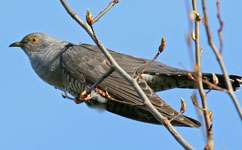Some birds use a different breeding strategy to others to avoid cuckoos infiltrating their nests, say scientists.
Cuckoos are known for laying their eggs in the nests of other birds, leaving the unsuspecting nest-owner to bring up the cuckoo as one of her own. But some birds are able to avoid this whilst others are targeted. Scientists had no idea why some can always escape, so an international team went to find out.
The study, published in Journal of Animal Ecology, found some female magpies can evade cuckoo parasitism by strategising when and how they build their nests.
'Almost 30 per cent of magpie females manage to escape parasitism through their lives, whereas the rest are parasitised, at least sometimes,' says Dr Mercedes Molina-Morales, lead author of the research, from the University of Granada.
The study was shows that these magpies have specific traits that put cuckoos off. 'It was surprising that despite high rates of parasitism in the population some years, there were females that consistently escaped parasitism, and that we could characterize them in terms of their phenotypic traits,' explains Molina-Morales.
Phenotypic traits are expressions of genes, like eye colour, but traits which can change depending on the environment. In magpies most phenotypic traits like body size and bill length have no bearing on whether or not a bird avoids parasistism, but the trait determing when the magpie chooses to breed did.
The ones who were most successful built large nests early in their breeding season. Early in the season the trees are bare and all nests are easily visible to cuckoos. During this time smaller nests have fewer sticks in their roofs and more entrances, making them more accessible and more likely to be targeted. So, magpies with larger, less-accessible, nests are more likely to escape parasitism.
But later in the breeding season it is the magpies who build small nests who evade cuckoos. This may be because trees become leafier and smaller nests are more easily hidden, so magpies that build small nests and conceal them in wooded areas are less likely to find a cuckoo moving in.
To leave their eggs in magpie's nests, the cuckoos normally distract the magpies. 'The males fly around the nest making noises and attracting the magpies. Then females fly into the nest and lay the eggs in a few seconds, from the rim of the nest,' Molina-Morales says.
Leaving other mothers to rear their young greatly benefits the cuckoo. It means cuckoos can 'save energy in most parental duties, such as incubation or chick feeding which allows an increase in the number of eggs that a female can lay in a breeding season,' says Molina-Morales.
But to promote its own wellbeing, the cuckoo jeopardises the health and life of other birds. A cuckoo in the nest will eat all of the food, starving young magpies. Cuckoo eggs can also sometimes break the magpie eggs when falling on them.
Birds that are able to consistently prevent their nests from being targeted avoid this and their young have a better chance of survival. 'The 30 per cent of females which avoid parasitism are more successful since they are able to rear twice the number of chicks than those that are parasitized,' explains Molina-Morales.
The next stage is for the team to find out what the mother does next if she finds her nest subject to a cuckoo invader.
More information: Molina-Morales, M., et al. (2013), Evidence of long-term structured cuckoo parasitism on individual magpie hosts. Journal of Animal Ecology, 82: 389-398. doi: 10.1111/1365-2656.12022
Journal information: Journal of Animal Ecology
Provided by PlanetEarth Online
This story is republished courtesy of Planet Earth online, a free, companion website to the award-winning magazine Planet Earth published and funded by the Natural Environment Research Council (NERC).






















